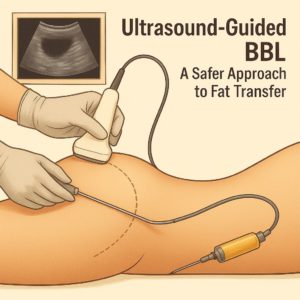The Brazilian Butt Lift (BBL) remains one of the most in‑demand body contouring procedures across the globe—but it hasn’t always had a spotless reputation. As more patients seek natural, hourglass curves through fat transfer, safety has become the leading concern. Enter ultrasound‑guided BBL—a refined technique that enhances the precision and safety of fat grafting by allowing surgeons to see exactly where fat is being injected in real time.
In this blog, we’ll break down how this technique works, why it’s safer, who it’s best for, what to expect during and after the procedure—and the Florida law that now mandates ultrasound guidance for gluteal fat grafting.

What Is an Ultrasound-Guided BBL?
A traditional BBL involves three main steps:
- Liposuction harvest — fat is harvested from areas like the abdomen, flanks, or thighs.
- Processing / purification — the fat is purified and prepared.
- Reinjection — the fat is injected into the buttocks in layers to build shape and volume.
While effective, traditional methods rely on anatomical landmarks and tactile feedback to guide placement. This means surgeons don’t always have visual confirmation of exactly where the cannula tip is, which can increase the risk of fat entering deeper zones.
An ultrasound‐guided BBL integrates real-time ultrasound imaging during fat injection. With an ultrasound probe positioned on the surface of the buttocks (or sometimes via auxiliary access), the surgeon can see the cannula tip, the fat plume, and the relative layers of tissue. This visual guidance helps ensure the fat is deposited in the subcutaneous layer above the muscle—the safest zone for grafting—which lowers risk and improves outcomes.
Why Safety Matters in BBL Surgery
BBL procedures made headlines over the past decade due to rare but serious complications. One of the most dreaded is fat embolism, where fat inadvertently enters the bloodstream and travels to the lungs or heart. Much of this risk stems from injections that penetrate or approach the gluteal muscle or vascular structures.
Because of those risks, the aesthetic surgery community has gradually shifted toward more conservative techniques. Now, many experienced surgeons—and even state regulators—insist on protocols that enforce safety during BBLs.
The keys surgeons emphasize today are:
- Always staying in the superficial (subcutaneous) plane, never intramuscular
- Avoiding deep placement and crossing fascial boundaries
- Using tools like ultrasound or equivalent imaging to guide injections
- Limiting delegation — the primary surgeon handles critical steps
Compared to blind injections, ultrasound guidance gives a visual check one can’t get otherwise. It becomes a safety net: if you see the cannula drifting deeper than intended, you adjust immediately. This helps reduce complications and gives patients peace of mind.
How Ultrasound-Guided BBL Is Performed
The overall flow of surgery is similar to a standard BBL, but with added imaging oversight.
- Liposuction & Fat Harvest: The surgeon harvests fat from donor areas (abdomen, waist, back, thighs). This step is essentially unchanged from traditional BBL.
- Fat Processing: The fat is purified (washing, filtering) to remove fluid, debris, and damaged cells. Only healthy fat is readied for injection.
- Ultrasound Setup: The surgical team positions an ultrasound transducer on the buttocks or flank area. The probe is sterile or covered appropriately, and the surgeon views a live imaging screen during grafting.
- Guided Fat Injection: Under ultrasound visualization, the surgeon inserts the cannula and watches the tip in real time. The ultrasound helps confirm that the cannula remains in the safe (subcutaneous) layer. Fat is delivered gradually, in small “boluses,” sculpting volume and contour incrementally and symmetrically.
- Final Contouring & Closure: After injections, the surgeon shapes and smooths, checks symmetry, and closes any access points.
Because of the imaging feedback, surgeons can refine how much fat is injected in each zone, increasing precision and reducing unnecessary trauma or overfilling.
Florida Law: Mandating Ultrasound Guidance (HB 1471)
A critical piece of this safety conversation is the new Florida state law, HB 1471, which took effect on July 1, 2023. This legislation establishes mandatory standards for gluteal fat grafting to help improve patient safety.
Key Provisions of HB 1471
- Physicians must perform an in-person examination at least one day before surgery.
- Both fat extraction and fat injections must be done by the physician, and cannot be delegated to assistants.
- Fat must be injected into the subcutaneous space only—it may not cross the gluteal muscle’s overlying fascia.
- Ultrasound guidance (or equivalent technology) is required during fat injection to help confirm placement in the subcutaneous plane.
This law codifies practices many top surgeons already follow, making ultrasound guidance not just a best practice—but a legal requirement in Florida. Patients now have greater regulatory protection, and surgeons are held to stricter standards for safety.
Why This Law Matters
This mandate helps ensure that surgeons practicing BBL surgeries in Florida use safer, more precise techniques. It also gives patients a legal assurance that the state recognizes the risk and demands advanced safeguards. Choosing a surgeon who complies with HB 1471 ensures you’re working with a provider committed to transparency, safety, and modern standards.
Benefits of Ultrasound-Guided BBL
Enhanced Safety & Legal Compliance: Using ultrasound ensures compliance with Florida law and decreases risk of vessel penetration or fat embolism.
Precise Volume Placement & Symmetry: Real-time visualization allows sculpting to be more nuanced and individualized.
Improved Fat Survival: Grafting in the optimal superficial plane supports better oxygenation and integration of fat cells.
Reduced Complications: Lower risk of hematoma, over-injection, or irregularities due to misplacement.
Greater Patient Confidence: Patients appreciate seeing that their surgeon is using advanced technology and following state mandates.
Who Is a Good Candidate for an Ultrasound‑Guided BBL?
You may be a good candidate if you:
- Are in generally good health without major comorbidities
- Have enough donor fat to harvest safely
- Want to avoid implants in favor of your own fat
- Value safety, precision, and long-term results
- Prefer a surgeon who uses imaging and is compliant with Florida’s laws
If you’re curious about BBL but concerned about risk, ultrasound‑guided BBL offers a more controlled, transparent approach to fat transfer.
Recovery Expectations (Ultrasound‑Guided BBL)
Recovery is similar to a standard BBL—with the potential benefit of fewer complications due to enhanced control. Here’s a typical timeline:
Week 1:
- Expect swelling, bruising, and soreness
- Avoid sitting directly on your buttocks
- Wear a compression garment as instructed
Week 2–4:
- Gradually resume light activity
- Still avoid prolonged sitting
- Fat survival stabilizes and swelling begins to diminish
Month 1–3:
- Most swelling subsides
- You may begin sitting normally and returning to routine workouts (with clearance)
- Results begin to settle and refine
Final results typically continue refining over 3 to 6 months, as the transferred fat integrates and residual swelling resolves.
Why South Florida Center for Cosmetic Surgery?
Our board-certified plastic surgeons prioritize patient safety without compromising on results. We are proud to offer ultrasound-guided BBL as part of our commitment to modern, responsible cosmetic care.
Our surgical team uses the latest imaging technology to ensure every fat transfer is performed with precision and safety in mind. When you choose SFCCS, you’re choosing experience, innovation, and a personalized approach to aesthetic care.
The rise of ultrasound-guided BBL is changing the game for patients who want beautiful, natural-looking curves without unnecessary risk. By embracing this innovative, safety-first approach, you can feel confident in your transformation from start to finish.
Ready to take the next step? Book a consultation with one of our skilled surgeons today to learn more about whether this advanced technique is right for you.




